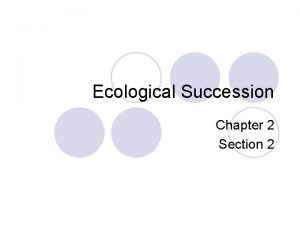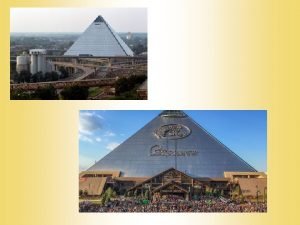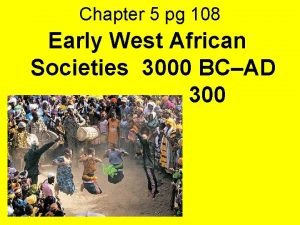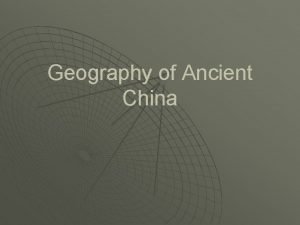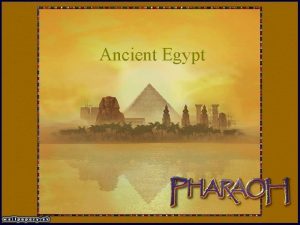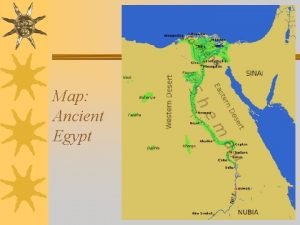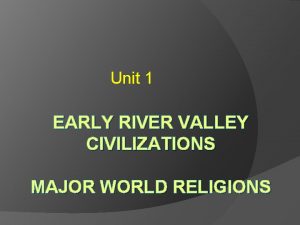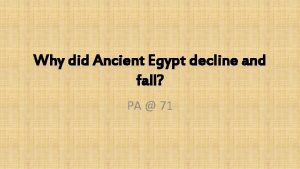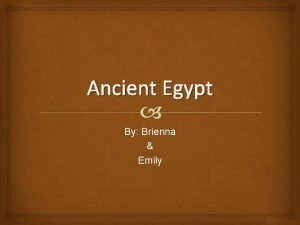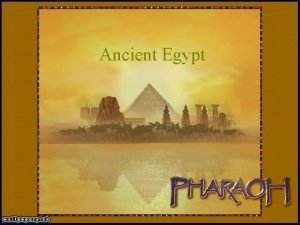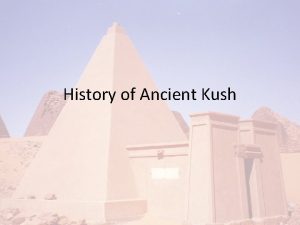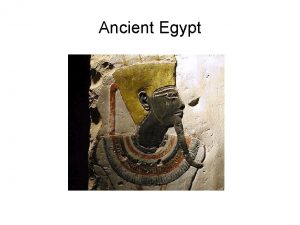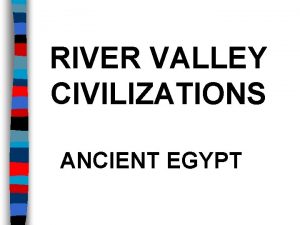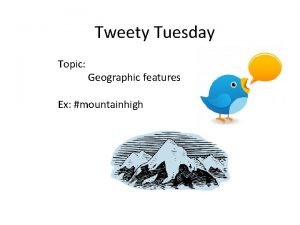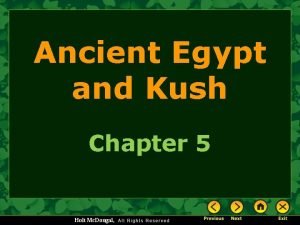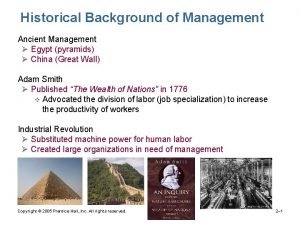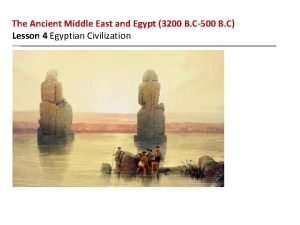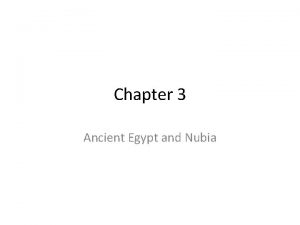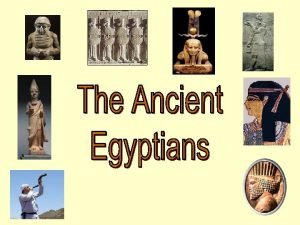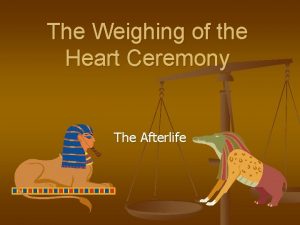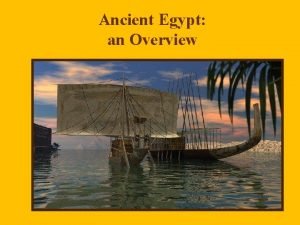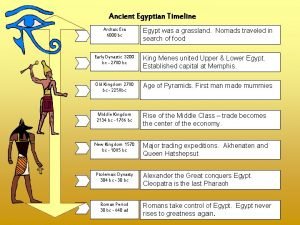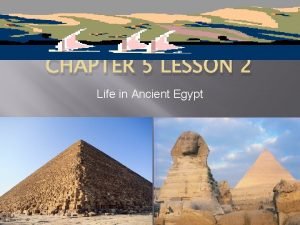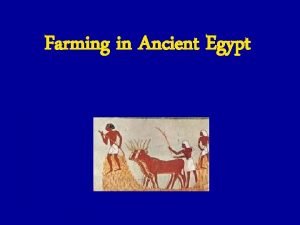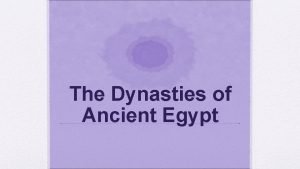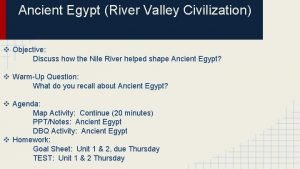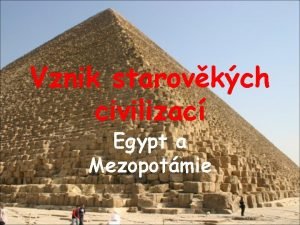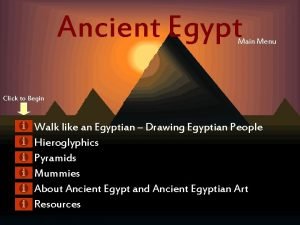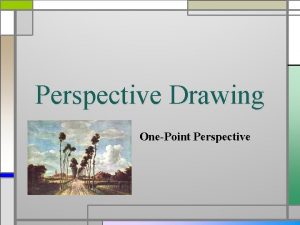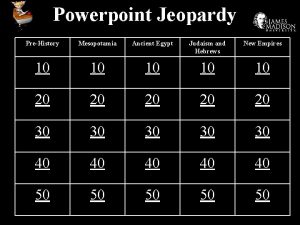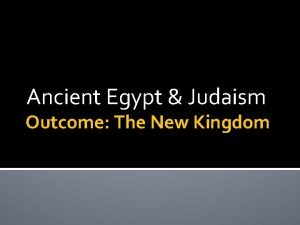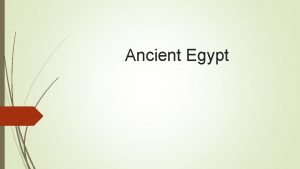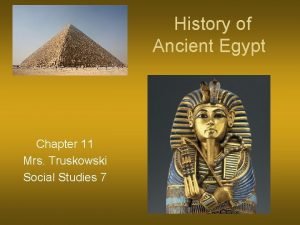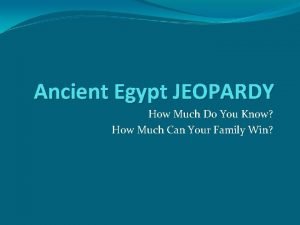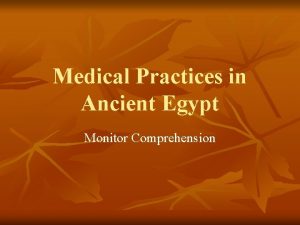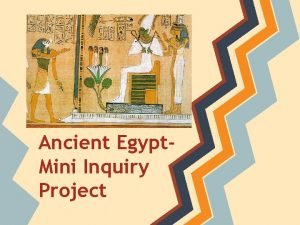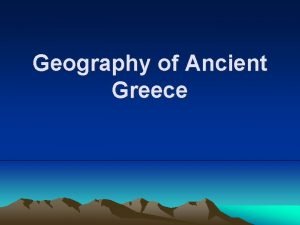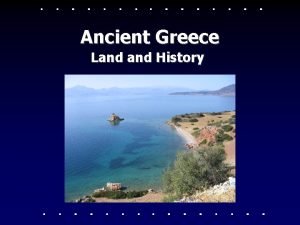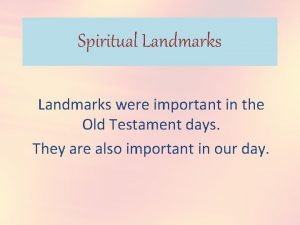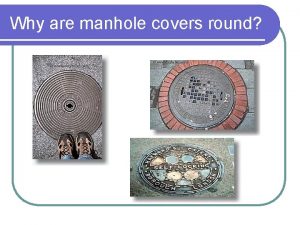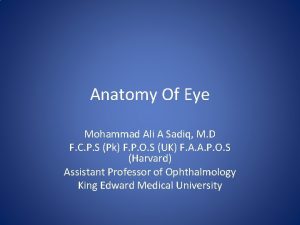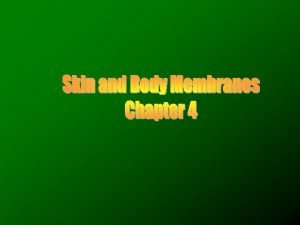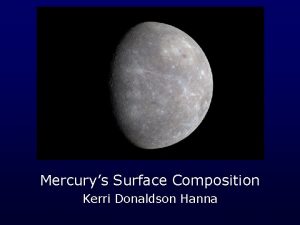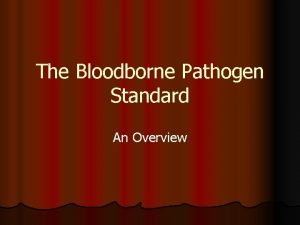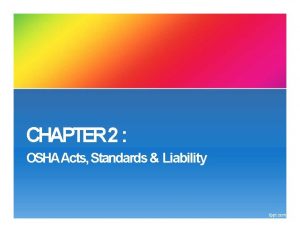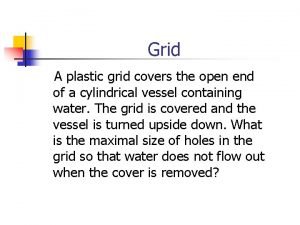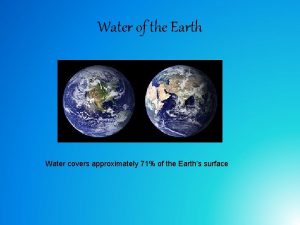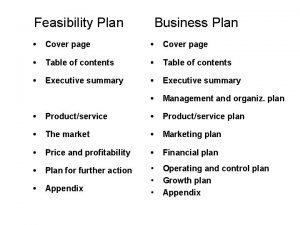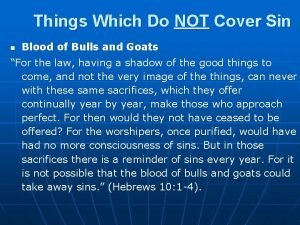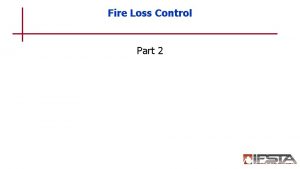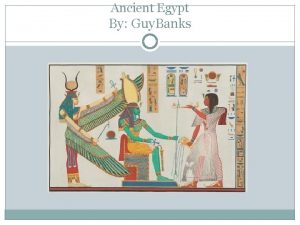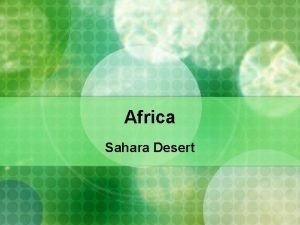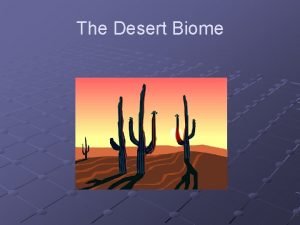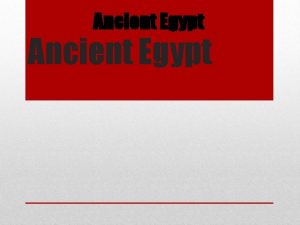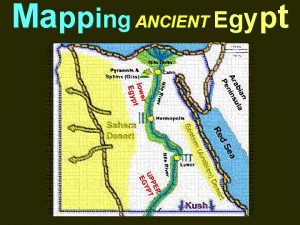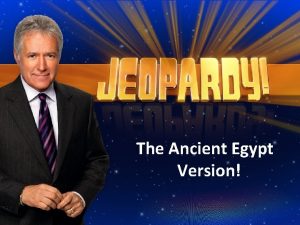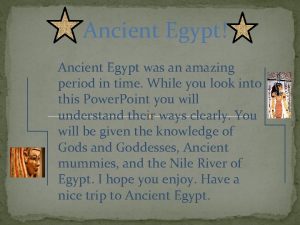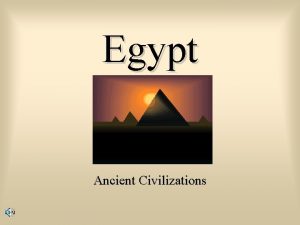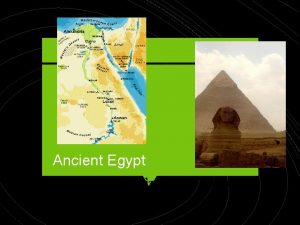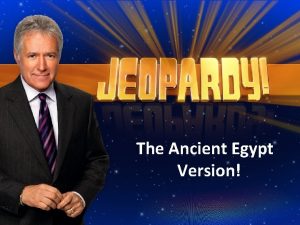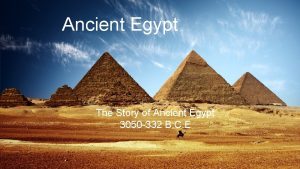Ancient Egypt Land of Egypt Today desert covers





































































































- Slides: 101

Ancient Egypt

Land of Egypt • Today, desert covers much of Egypt. It hardly ever rains in Egypt • 12, 000 yrs. Ago, much of the area was covered by swampland. • Since then, Egypt has been getting drier. • Egypt has been mostly desert for at least 5000 yr. • The most important feature is the Nile.

The Land of Egypt • The Nile was the main source of water in Egypt. • Herodotus said: “Egypt is the gift of the Nile”. – Without the Nile, Egypt would have been a desert, with very little life. Because of the Nile, it was a land of great fertility, and one of the cradles of civilization. • Black Land: land on each side of the Nile river, which receives water. It is rich and fertile. • Red Land: land just beyond the Black Land. It is desert.

Black land/Red Land

• Nile is the longest river in the world-4160 miles • The White Nile starts at Lake Victoria. The Blue Nile starts in the highlands of Ethiopia. • They come together in what is now Sudan, to form the Nile.

• Lower Egypt is in the north • Upper Egypt is in the south

• Cataracts are rapids • There were 6 main cataracts on the Nile • You could not navigate through the cataracts. • Ancient Egypt 750 miles from the first cataract to the Nile delta.

• The Nile flows from south to north • The wind blows from north to south. • This made travel easy in both directions

Inundation (flood) of the Nile • Each year, in late June, the water level of the Nile River began to rise. The star Sirius appeared above the horizon just before dawn on June 21. • The flood was caused by spring rains farther south in Africa, where the Nile river begins. • The water level continued to rise until it reached its maximum in September. In October the water level began to fall, and within a few weeks was back to its original level. • As the flood water receded, it left a layer of rich, fertile black silt, which was ideal for crops.

Life in Egypt followed the cycle of the Nile • Egyptian farmers divided their year into three seasons, based on the cycles of the Nile River: • INUNDATION (FLOOD SEASON)(June-September): No farming was done at this time, as all the fields were flooded. Instead, many farmers worked for the pharaoh (king), building pyramids or temples. Some of the time was spent mending their tools and looking after animals. • GROWING SEASON(October-February): After the flood receded, in October, this fresh, fertile soil was ploughed and seeded. The crops, including wheat, barley, flax, figs & pomegranates, grew. • HARVEST SEASON (March-May): The fully grown crops had to be cut down (harvested) and removed before the Nile flooded again. It was also the time to repair the canals ready for the next flood.


• Inundation: means covered with water; the term for the flood of the Nile. • Nilometer: an ancient device for measuring the height of the Nile flood waters. These were located at a number of places on the Nile.

Flood of the Nile-Life of the People • The annual flood of the Nile determined the rhythm of life in Egypt: Inundation, Growing Season, Harvest. • The annual flood left rich silt made Egypt almost magically fertile. This meant the Egyptians could produce a lot of surplus food, which allowed them to do many things other than farming. • This cycle gave the Egyptians a deep sense that life follows a cycle, and that life is renewed.


Other advantages of the Nile Valley • Extremely fertile soil • Sunny, frost-free climate • Easy travel by boat on the Nile in both directions. • Plenty of stone for building. • A location protected from invasion. • Deserts provide protection on the East and West. The Isthmus of Suez was the only landbridge to Asia • The Mediterranean Sea provided protection on the North. • The cataracts helped protect from invasion from the South. • Because of this natural protection, Egypt was not often invaded in the early period. This helped allow their culture to develop.

Very Early Developments • By at least 6000 BC, there were farming villages along the Nile. • By 3800 BC, the Egyptians mined copper, and soon learned to make bronze • By 3100 BC, there were two kingdoms in Egypt: Upper Egypt and Lower Egypt. Also by this • Also by 3100 BC, Egypt began developing a vast irrigation system to bring Nile water to crops in the dry season.


3100 BC-Unification • In 3100 BC, Menes (Narmer) , the ruler of Upper Egypt, conquered Lower Egypt, and united the 2 kingdoms. • Thus Egypt became the world’s first unified country. • To show this, Menes combined the crowns of Upper and Lower Egypt into one crown • He established Memphis as the capital. • According to legend, Menes was killed and eaten by a hippopotamus.

Pharaohs & government • Dynasty: family of rulers. 30 Dynasties of Ancient Egypt. • Pharaoh: Ruler of Egypt, who was regarded as a god. The position was passed down usually from father to son. They were absolute rulers, and in theory owned all the land of Egypt. They were human forms of the god Horus. • To help them rule, the pharaohs created a complex bureaucracy. – Vizier – assistant to the pharaoh. – Governmental departments to handle the various functions of government. • Many scribes worked in each department to carry out the tasks of government.

Egyptian writing-Hieroglyphics • Hieroglyphics – Oldest form of Egyptian writing; It was fully formed by about 3000 BC, although some written symbols were used as early as 3400. – “hiero”-holy; “glyphics”-writing – About 600 picture signs. Some represented whole words. Some represented syllables. – It was originally carved on stone. Soon papyrus was used as a writing material.

Papyrus • Papyrus was made from the stalk of the papyrus plant – – Peel the stalk. Cut the stalk into strips. Soak the strips. Lay them out. Press them. • They used ink made from soot, water, and sometimes plant juice

Egyptian writing • After hieroglyphics, more simplified forms of writing were invented. Hieroglyphics continued to be used for very formal writing. • Hieratic: also used pictures, but they were simplier • Demotic: uses simple strokes.

What happened to Egyptian writing • Eventually, by about 300 AD, many years after the period we are studying, all three forms of Egyptian writing went out of use. • For a while, the Egyptians used Greek or Latin. Later, the Egyptians used Arabic. • The meaning of the old symbols was forgotten. No one knew how to read them.

HOW HIEROGLYPHICS (and hieratic and demotic) were finally translated: • In the 1700 s, interest in Ancient Egypt increased, and people wanted to be able to read hieroglyphics. • 1799 AD – a stone was found by Napoleon’s soldiers near the town of Rosetta, Egypt - - the “Rosetta Stone”.

Rosetta Stone • It happened to have a royal proclamation written in 3 different ways: Hieroglyphics, Demotic, and Ancient Greek. • Ancient Greek was still well known by many people. • In 1822, a French linguist named Francois Champollion used the Rosetta stone to decipher the hieroglyphics and demotic. He knew the Ancient Greek language and used it as a key to the others.

Periods of Egyptian History • About 3100 BC-2700 BC: Early Dynastic Period • About 2700 BC-2200 BC: OLD KINGDOM – About 2200 BC-2100 BC: 1 st Intermediate period • About 2100 BC-1700 BC: MIDDLE KINGDOM – About 1700 BC-1600 BC: 2 nd Intermediate Period • About 1600 BC-1100 BC: NEW KINGDOM • * All dates are rounded up to the nearest century

Accomplishments of the Early Dynastic period: 3100 BC-2680 BC: • Unified Upper & Lower Egypt & established a strong central government, Established the position of a king called the pharaoh • Developed a tradition of mummifying & burying rulers in mastaba (rectangular) tombs. • Developed hieroglyphic writing. • Established the irrigation system

OLD KINGDOM (2680 BC- 2180 BC) • Improved the irrigation system • Made the government highly centralized and highly organized • Build the great pyramids and sphinx

SOCIAL CLASSES • 1)Pharaoh & the Royal Family • 2) Government officials, nobles, priests & scribes. – Government officials who governed the provinces of Egypt was divided into 42 provinces called Nomes, and these officials were called Nomarchs. These officials gradually became a small but powerful group of hereditary nobles; – Priests; Scribes (people whose profession was reading and writing). • 3)Skilled artisans and merchants • 4)Peasant farmers (these were the majority) • (In Old Kingdom Egypt, there were few slaves. Later, in Middle and New Kingdom periods, the number of slaves greatly increased.

PYRAMIDS • There are over 100 pyramids in Egypt, built during the Old Kingdom and Middle Kingdom periods. • The largest and oldest pyramids were built during the Old Kingdom. They are located on in lower Egypt, near present day Cairo, in three locations: Giza, Saqarra, and Dashur.


Pyramids • The purpose of the pyramids was to provide a tomb that would protect the body and soul of the Pharoah. • They believed that the soul (composed of ba and ka) needed its body in order to have eternal life, and the body therefore had to be preserved and protected. • Most Pharaohs started building their tombs many years before they died.

• It used to be thought that the pyramids were built by slave labor. However, now historians have determined that they were built by free Egyptian citizens who were drafted by the government to spend a certain time building pyramids. • They were organized into work-groups and lived in a village set up near the pyramid. • Some groups even had nick names for their group and signed the part of the pyramid they built.

PYRAMIDS • The early Pharoahs had rectangular tombs called Mastaba tombs. They were buried in a shaft beneath them.


Pyramids-1 st Pyramid • The Pharoah Djoser reigned in 2630 -2611 BC, during the Old Kingdom. • His vizier and architect was an man named Imhotep designed Djoser’s tomb. • Djoser’s tomb started off as a Mastaba tomb. Then (to make it grander) Imhotep added a series of progressively smaller Mastabas on tomb. Thus we have the first pyramid: the “Step Pyramid”

Djoser-1 st Pyramid


Sneferu-2 nd 3 rd 4 th pyramids

2 nd pyramid (Sneferu’s 1 st)

3 rd pyramid (Sneferu’s 2 nd)

4 th Pyramid (Sneferu’s 3 rd)


Khufu-builder of the 5 th and Greatest Pyramid

5 th and Greatest Pyramid

5 th and Greatest Pyramid

Khufu’s boat

6 th Pyramid-Khafre

6 th - Khafre

6 th - Khafre

The Great Sphinx goes with Khafre’s Pyramid


7 th - Menkaure

Menkaure


8 th Pyramid-Pepi II - Saqarra

1 st INTERMEDIATE PERIOD: 2180 BC-2050 BC • Toward the end of the Old Kingdom Period, the strength of the central government began to decline. • Pepi II, last ruler of the Old Kingdom, just lived too long. He became weaker, and the local nobles grew more powerful and rebelled. • For about 100 years, there were civil wars as these nobles rebelled against the central government. • Finally, order was restored. The capital was moved from Memphis to Thebes (farther south-”up” the Nile)

MIDDLE KINGDOM (2050 -1650 BC) • Accomplishments: • Overall, called a golden age, marked by stability and prosperity • Repaired and improved the irrigation system • Drained swampy areas in the delta and created new farm land. • Conquered Nubia, the land to the south

2 nd INTERMEDIATE PERIOD: (about 1650 -1570 BC) • Near the end of the Middle Kingdom period, nobles and priests became more independent, and the kingdom became less stable. The weakened the position of the Pharaoh weakened. • A people called the Hyksos, who were nomadic herders from the Middle East, came into Egypt and (temporarily) took control in Lower (northern) Egypt. They had a new war weapon: the war chariot. They controlled much of Egypt for a time. • Two versions of the Hyksos – Manetho (Egyptian historian 200 BC) said the Hyksos invaded, destroyed cities, murdered & enslaved Egyptians – Some modern historians think that first the Egyptian government weakened, and then the Hyksos migrated in and took control without any great amount of violence.

BEGINNING OF THE NEW KINGDOM (1570 BC-1080 BC) • AHMOSE: – About 1570 BC, a strong, talented young ruler from Thebes rallied the Egyptian forces and drove the Hyksos out of Egypt. • Several strong pharaohs followed. • CHANGES DURING THE NEW KINGDOM. Egypt: • Used war chariot. Became conquerors. Built an empire. • No longer built pyramids for their pharoahs. They built hidden tombs in the Valley of the Kings.

FAMOUS NEW KINGDOM PHARAOHS- HATSHEPSUT • 0 nly female pharaoh who ruled in her own name • Ruled 1503 BC-1482 BC • Oldest daughter of Pharaoh Thutmose I. She married her half brother Thutmose II, and then he died. They had no son together. • Hatshepsut & her young stepson, Thutmose III became co-rulers. Soon she declared herself pharaoh, and began dressing in the traditional dress of the pharaoh, including the fake beard.

HATSHEPSUT • Major accomplishment-a famous trading expedition to Punt. • After her death, her step-son Thutmose III took over and tried to erase her name from monuments. • Recently her mummy was identified. Her mummy had no identification on it. Archeologists found a box with her name on it with a tooth inside. They tooth fit the unidentified royal female mummy.

Hatshepsut’s funerary temple

FAMOUS NEW KINGDOM PHARAOHS- Thutmose III • Tremendously successful warrior pharaoh and conqueror. • Ruled 1482 BC-1450 BC • Conquered Palestine & Syria to the east. Conquered more of Nubia in the south. • Now Egypt was a true Empire. Brought Egypt to the height of its military power.

Famous New Kingdom Pharaohs: Amenhotep IV/Akhenaton • Ruled 1380 -1362 BC • During most of their history, Egyptians worshiped many gods---polytheistic. The chief god was Amon-Re (Ra), but many others were worshiped. • Akhenaton came to believe that there was only one god – Aton –the sun-disk. He became a monotheist. • He ordered that Egyptians quit worshiping all the other gods, including Amon-Re, and worship only Aton. He closed the temples of the other gods and the priests lost their jobs. • To make a break with the past, he built a new capital city called Amarna, and moved the court.

AKHENATON • His wife, the beautiful Nefertiti, was almost a co-ruler with him. • Akhenaton was so obsessed with his new monotheistic religion, that he neglected other needs of the country, and Egypt lost some control of some of the empire Thutmose III had conquered. • After the death of Akhenaton, Egypt went back to worshiping the old gods, including Amon Re (Amon Ra

Akhenaton, Nefertiti, and their daughters. Sun disk Aton with little “hands” reaching down to earth.

AKHENATON & NEFERTITI

Famous New Kingdom Pharaohs: Tutankhamen • Had no great accomplishments and died very young, age 19 • Ruled 1333 BC-1323 BC • Restored the worship of the old gods, including Amon Re (Ra) • He is famous because his tomb was found with the contents still in it. • It was found by Archeologist Howard Carter in 1922.

Famous New Kingdom Pharaohs: Ramses II (Ramesses II) • One of the last strong pharaohs of the New Kingdom • Ruled 1279 BC-1213 BC • Constructed many temples and monuments, and had many statues made of himself!!! • Lived to be 90 -91 year old. Had over 100 children. • Is thought to be the pharaoh at the time of the “Exodus”, when Moses led the Hebrews out of Egypt.

Ramses II at the Battle of Kadesh


Temple at Abu Simbel-All 4 colossal statues depict Ramses II

Section 2 • Important general characteristics of Egyptian Culture: • Stability based on – dependability of the annual Nile inundation – geographic isolation - relatively protected from frequent invasions by the surrounding deserts • Deep interest in life after death: – the annual flood of the Nile led to confidence in the renewal of life – Much of the architecture involved belief in life after death

Achievements in architecture • OLD KINGDOM PYRAMIDS – They did not have wheeled vehicles or cranes – Most historians think they used temporary ramps of dirt to haul the stones up the sides of the pyramids. – Straight ramp theory-on each side a long straight ramp of dirt was built, higher as the pyramid was built higher. – Spiral Ramp theory – Either theory: Stones were hauled up the ramps. After the pyramid was finished, the ramps were torn down.

Achievements in Architecture • Middle Kingdom pyramids – Limestone outside, mud brick inside – Now many are rubble • New Kingdom Tombs (Valley of the Kings) – In the new kingdom, the capital was moved to Thebes – Pharaohs began building tombs on the west bank of the Nile at the Valley of the Kings, across from Karnak & Thebes – Long passageways and rooms carved into the rock & hidden – Richly decorated inside, painted from top to bottom (Theban Mapping Project) • Great Temples: – Great temples such as the one at Karnak, with huge columns.

Achievements in sculpture & painting • Small statues of everyday life placed in tombs • Huge statues such as the ones at Abu Simbel and the Great Sphinx • Exquisite paintings in tombs


Calendar, Math, Medicine • Egyptian Calendar – First calendar was lunar, based on the moon – Solar (365 day calendar) developed. – They noticed that a star – Sirius – appeared on the horizon shortly before the flood began. Solar year began with the rising of Sirius (about June 21) to the next rising of Sirius. – Year divided into 12 months of 30 days + 5 days for holiday & feasting – Kept track of years, by the reign of the pharaoh • Mathematics-base 10 system – number system – base 10 – Used geometry to build the pyramids & re-draw the boundaries of fields after the flood

Calendar, Math, Medicine • Knew a lot about human anatomy, because of the mummification process • Mixed true medical knowledge with magic. • Herbal medicines, surgery, setting broken bones.

Education – Schools established for boys who would become scribes--men who could read & write. – Scribes were professional record keepers. – Many scribes worked for the government.

Egyptian Religion • Polytheistic – about 2000 gods & goddess (except during the reign of Akhenaton! • In very early Egypt, many villages had their own god/gods. As Egypt became more unified, some of these gods came to be worshiped all over Egypt. • Gods often had an animal symbol. Some animals were also sacred: cat, crocodile, scarab beetle • Chief god: Amon, or Amon-Re (Amon=Amun; Re=Ra). Originally Amon and Re were two separate gods, but they eventually merged.

Osiris & Isis story • Long ago, Osiris was the ruler of Egypt; Isis -his wife; Set- brother of Osiris. • Osiris and Isis were beloved by the people, and Set was jealous. • Set makes a coffin, tricks Osiris into getting into it, slams it shut, and throws it into the Nile. • Isis finds the coffin & body of Osiris; • Then Set gets Osiris again and tears Osiris apart, and throws out the pieces. • Isis & Anubis find the pieces & Isis brings Osiris back to life. • Osiris reigns as king of the dead. He is also associated with the Nile, which flooded and receded. Osiris periodically died and was reborn. • Isis represents life, and the ankh is the symbol of Isis

• The deceased makes a negative confession that he is innocent of wrong doing towards the gods and his fellow men • Anubis leads the deceased to the scales. • The scale is topped by Maat, goddess of justice. • Anubis weighs the heart against the feather of Maat. • Thoth records the result. • If the heart weighs more, his soul is eaten by Ammut. • If the heart passes the test, he is led by Horus to meet Osiris. The 4 sons of Horus stand on a lotus flower, and Isis and her sister Nephthys.

Status of Women • Division of labor: – Men did most of the physical labor, such as farming, outside the home. – Women took care of children, cooked, took care of gardens near the home. As a result, men are usually portrayed in art as more tanned than women. • Women were not completely equal to men. It was rare for a woman to be pharaoh. Women were rarely scribes or taught to read and write. • However, women had many legal rights that were equal to men. Unlike women in many other ancient societies, they could own property. They could buy and sell property. They could operate businesses (if they had the means to do so). They had the legal right to do what a man of their social class could do. • Art shows that family, marriage and children were highly valued.

Art shows that family, marriage and children were highly valued.



LAND • In theory all land was owned by the Pharaoh. It was divided into large estates controlled by nobles. The nobles were like land-lords. Peasants had pieces of land on the noble’s estate, which they farmed. A portion of the peasant’s crop went to the noble, and a portion went to the Pharaoh. • The peasants used simple tools of stone and wood, such as hoes. They used wooden plows pulled by oxen.

Farming & irrigation • The fresh soil left after the flood made the land very fertile. The fields were irrigated. Irrigation ditches (canals, channels) crisscrossed the fields

• . In the new kingdom, a mechanism called a shaduf was used to lift water and pour it on the fields, or to move water from a lower level to a higher level.

• The most important crops were wheat (for bread), barley (for bread or beer), and flax, which was woven into linen cloth. Other vegetables and fruits such as dates and figs were also grown. (cotton was grown at a later time than the time we are studying). • • The farmers planted in the fall (about November) after the water of the inundation (flood) had receded. They harvested in the spring (March/April/May) before the next flood. Sometimes they were able to plant and harvest more than one crop in a season. The annual flood determined this schedule.

FOOD • The most important food was bread, and the most important drink was beer. Many vegetables and fruits, such as dates and figs were also eaten. They also ate fish, ducks, geese and cheese.

CLOTHING • Most clothing was made of whitish linen (which was made from flax). Richer people wore thinner, finer linen, poor people wore coarser linen. • Men wore “kilts” – short skirts-, and usually were bare-chested. Women wore long dresses with straps over the shoulders. • Small children often went naked. • For the wealthy the simple clothing was dressed up with jewelry and beaded collars. Even poorer people had simple jewelry.

• For the wealthy the simple clothing was dressed up with jewelry and beaded collars. Even poorer people had simple jewelry. Priests often wore leopard skins.

• Both men and women often (but not always) wore wigs. Men wore short hair, and shaved (or plucked) their faces, except sometimes leaving a small “goatee”. Women’s styles varied. In the old kingdom, a short chin-length bob was common for women. In later periods long hair for women was the preferred style.

• Many men and women shaved (or plucked) their bodies. Priests always shaved (or plucked) their heads and entire bodies.


• Both men and women wore makeup, especially eye makeup. Heavy black eyeliner (sometimes it was green) was used by both sexes. The black eyeliner was called kohl. Oils were used to keep the skin from drying out. Perfume was used.

HOMES • Homes for ordinary people were made of mud brick, and had flat roofs and 2 -3 rooms. Wealthier people had much larger more elaborate homes.

TRADE • Trade was regulated by the government. Long distance trade was carried on by caravan traders. They rode donkeys & later camels. Egypt usually had extra food to sell.
 The soldier decided to desert his dessert in the desert
The soldier decided to desert his dessert in the desert Succession definition biology
Succession definition biology Upper egypt and lower egypt
Upper egypt and lower egypt A strip of land that divides the desert from wetter areas
A strip of land that divides the desert from wetter areas Egypt ancient clothing
Egypt ancient clothing Taklamakan desert map
Taklamakan desert map Meeting objective
Meeting objective Galton details
Galton details For todays meeting
For todays meeting Today's lesson or today lesson
Today's lesson or today lesson We are going today
We are going today Example of repitition
Example of repitition Ancient egypt map
Ancient egypt map Non chronological report about egypt
Non chronological report about egypt Ancient egypt drawings easy
Ancient egypt drawings easy Outline map of ancient egypt
Outline map of ancient egypt Chief god of egypt
Chief god of egypt Ancient egypt civilization
Ancient egypt civilization Economy of ancient egypt
Economy of ancient egypt Why did egypt fall
Why did egypt fall Ancient egypt basic needs
Ancient egypt basic needs Geographical map of ancient egypt
Geographical map of ancient egypt Ancient egypt british council
Ancient egypt british council Kush on the map
Kush on the map Disadvantages of ancient egypt geography
Disadvantages of ancient egypt geography Natural barriers of china
Natural barriers of china Ancient egypt social structure
Ancient egypt social structure How did the nile shape ancient egypt essay
How did the nile shape ancient egypt essay Map of egypt and kush
Map of egypt and kush Contingency theory of leadership
Contingency theory of leadership Fomro
Fomro Egyptian hierarchy
Egyptian hierarchy Map of ancient egypt and nubia
Map of ancient egypt and nubia Ancient egypt civilization geography
Ancient egypt civilization geography Thoth weighing of the heart
Thoth weighing of the heart Egypt 3 kingdoms
Egypt 3 kingdoms Egyptian social pyramid
Egyptian social pyramid Specialized jobs in ancient egypt
Specialized jobs in ancient egypt Ancient egypt slogans
Ancient egypt slogans Egyptian religion timeline
Egyptian religion timeline Ebers papyrus
Ebers papyrus Egyptian social pyramid
Egyptian social pyramid J
J What crops did ancient greece grow
What crops did ancient greece grow Ancient egypt vocabulary words
Ancient egypt vocabulary words Fun facts for greece
Fun facts for greece How did the nile shape ancient egypt dbq answer key
How did the nile shape ancient egypt dbq answer key Ancient egypt bell ringers
Ancient egypt bell ringers American federal floral design history
American federal floral design history Achievements of ancient egypt
Achievements of ancient egypt Frontalism ancient egypt
Frontalism ancient egypt Ancient egypt
Ancient egypt Mesopotamia jeopardy
Mesopotamia jeopardy Ancient egypt and judaism outcome the new kingdom
Ancient egypt and judaism outcome the new kingdom Advanced cities ancient egypt
Advanced cities ancient egypt How old is ancient egypt
How old is ancient egypt Jeopardy ancient egypt
Jeopardy ancient egypt Ancient egypt transportation
Ancient egypt transportation Medical practices in ancient egypt answer key
Medical practices in ancient egypt answer key Frontalism ancient egypt
Frontalism ancient egypt Economy of ancient egypt
Economy of ancient egypt What is the relative location of egypt
What is the relative location of egypt Ancient egypt bell ringers
Ancient egypt bell ringers Ancient greece map colored
Ancient greece map colored A pointed piece of land extending into the sea
A pointed piece of land extending into the sea What are landforms
What are landforms Ancient greece land
Ancient greece land Ancient landmark definition
Ancient landmark definition Ancient land of punt
Ancient land of punt Pictures of ancient and modern means of communication
Pictures of ancient and modern means of communication Ancient india vs ancient china
Ancient india vs ancient china Why are manhole covers round
Why are manhole covers round Pars plicata
Pars plicata Covers body surfaces and lines body cavities
Covers body surfaces and lines body cavities Mercurys surface
Mercurys surface Chapter 15 digestive system
Chapter 15 digestive system Magazine covers design
Magazine covers design Osha's bloodborne pathogens standard covers
Osha's bloodborne pathogens standard covers It is movable plate that covers the shuttle
It is movable plate that covers the shuttle The scope of fma 1967 covers in the following sectors
The scope of fma 1967 covers in the following sectors Medicare part d covers
Medicare part d covers Reflection about invictus
Reflection about invictus Whats mood in literature
Whats mood in literature Front magazine covers
Front magazine covers Wetland ecosystem definition
Wetland ecosystem definition Grid
Grid Magazine covers 1920s
Magazine covers 1920s Medicare part d covers
Medicare part d covers Water covers approximately
Water covers approximately What ports are defined above 49 152
What ports are defined above 49 152 Companion diagnostic
Companion diagnostic Trigono sternocostale
Trigono sternocostale Membrane covers the heart
Membrane covers the heart Skate magazine covers
Skate magazine covers Antimicrobial stethoscope covers
Antimicrobial stethoscope covers Cover page for business plan
Cover page for business plan Magazine front cover features
Magazine front cover features Blood covers sin
Blood covers sin Double-layered pleural membrane
Double-layered pleural membrane Methods for salvage covers
Methods for salvage covers Match it food
Match it food Rastriya madhyamik shiksha abhiyan
Rastriya madhyamik shiksha abhiyan

